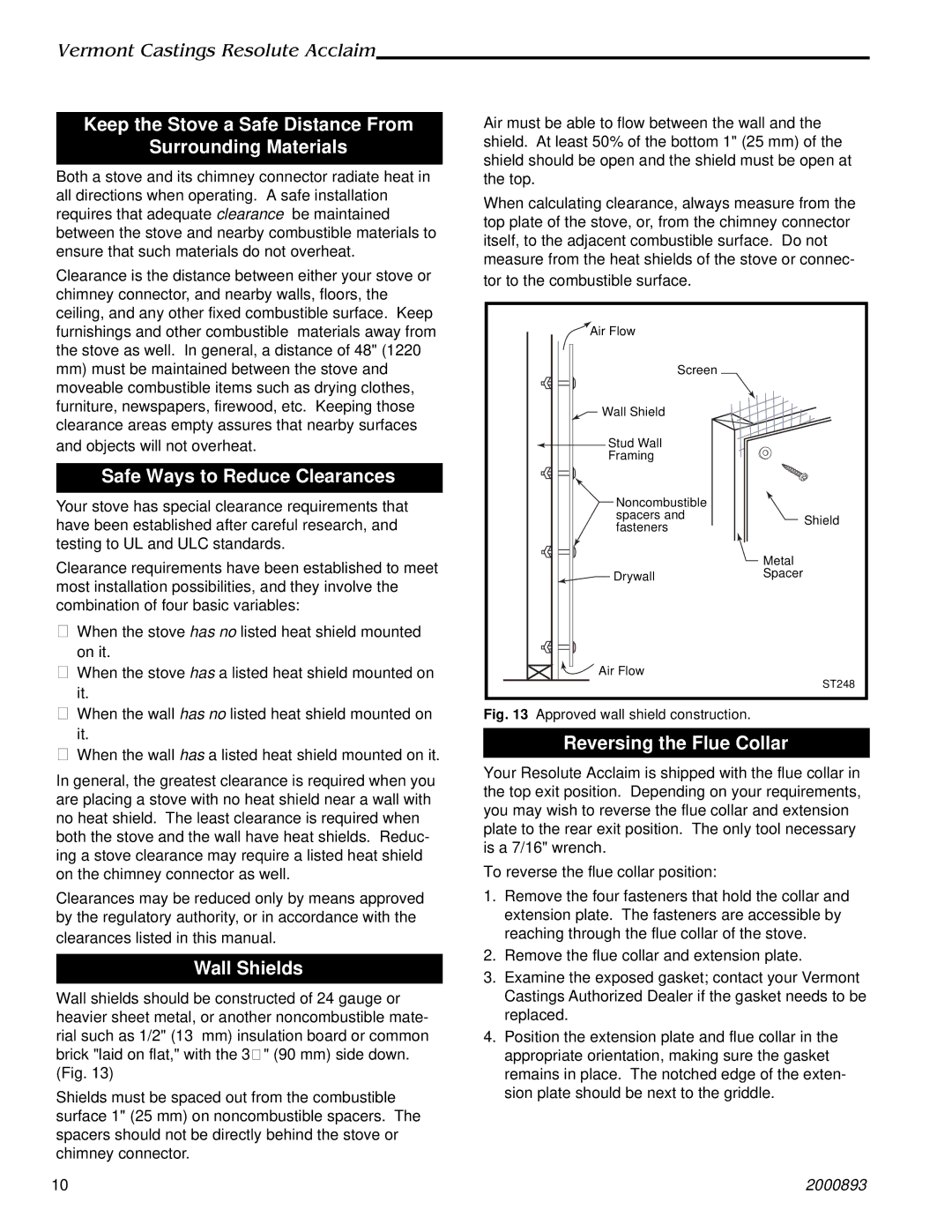
Vermont Castings Resolute Acclaim
Keep the Stove a Safe Distance From
Surrounding Materials
Both a stove and its chimney connector radiate heat in all directions when operating. A safe installation requires that adequate clearance be maintained between the stove and nearby combustible materials to ensure that such materials do not overheat.
Clearance is the distance between either your stove or chimney connector, and nearby walls, floors, the ceiling, and any other fixed combustible surface. Keep furnishings and other combustible materials away from the stove as well. In general, a distance of 48" (1220
mm)must be maintained between the stove and moveable combustible items such as drying clothes, furniture, newspapers, firewood, etc. Keeping those clearance areas empty assures that nearby surfaces and objects will not overheat.
Safe Ways to Reduce Clearances
Your stove has special clearance requirements that have been established after careful research, and testing to UL and ULC standards.
Clearance requirements have been established to meet most installation possibilities, and they involve the combination of four basic variables:
•When the stove has no listed heat shield mounted on it.
•When the stove has a listed heat shield mounted on it.
•When the wall has no listed heat shield mounted on it.
•When the wall has a listed heat shield mounted on it.
In general, the greatest clearance is required when you are placing a stove with no heat shield near a wall with no heat shield. The least clearance is required when both the stove and the wall have heat shields. Reduc- ing a stove clearance may require a listed heat shield on the chimney connector as well.
Clearances may be reduced only by means approved by the regulatory authority, or in accordance with the clearances listed in this manual.
Wall Shields
Wall shields should be constructed of 24 gauge or heavier sheet metal, or another noncombustible mate- rial such as 1/2" (13 mm) insulation board or common brick "laid on flat," with the 3¹⁄₂" (90 mm) side down. (Fig. 13)
Shields must be spaced out from the combustible surface 1" (25 mm) on noncombustible spacers. The spacers should not be directly behind the stove or chimney connector.
Air must be able to flow between the wall and the shield. At least 50% of the bottom 1" (25 mm) of the shield should be open and the shield must be open at the top.
When calculating clearance, always measure from the top plate of the stove, or, from the chimney connector itself, to the adjacent combustible surface. Do not measure from the heat shields of the stove or connec- tor to the combustible surface.
Air Flow |
| |
Screen |
| |
Wall Shield |
| |
Stud Wall |
| |
Framing |
| |
Noncombustible |
| |
spacers and | Shield | |
fasteners | ||
| ||
| Metal | |
Drywall | Spacer | |
Air Flow | ST248 | |
|
Fig. 13 Approved wall shield construction.
Reversing the Flue Collar
Your Resolute Acclaim is shipped with the flue collar in the top exit position. Depending on your requirements, you may wish to reverse the flue collar and extension plate to the rear exit position. The only tool necessary is a 7/16" wrench.
To reverse the flue collar position:
1.Remove the four fasteners that hold the collar and extension plate. The fasteners are accessible by reaching through the flue collar of the stove.
2.Remove the flue collar and extension plate.
3.Examine the exposed gasket; contact your Vermont Castings Authorized Dealer if the gasket needs to be replaced.
4.Position the extension plate and flue collar in the appropriate orientation, making sure the gasket remains in place. The notched edge of the exten- sion plate should be next to the griddle.
10 | 2000893 |
